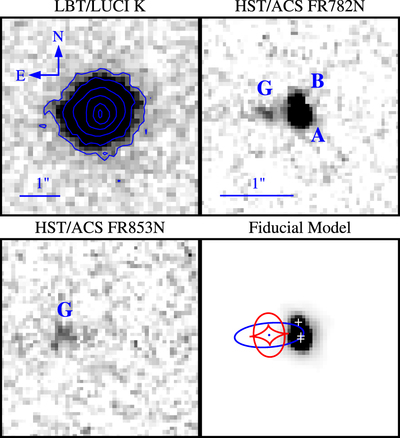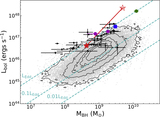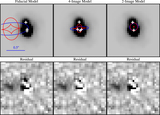Image Details

Caption: Figure 3.
High-resolution images of the strongly lensed quasar J0439+1634 and the best-fit three-image lensing model. A: LBT/ARGOS LUCI image in the K band. With ground-layer AO correction, the FWHM of the PSF is 0.″24. The quasar image has an FWHM of 0.″30 ± 0.″01. The contours show the image core elongated in the north–south direction as well as excess light toward the east, consistent with the high-resolution HST imaging. B: HST/ACS WFC image with the FR782N ramp filter centered at 7700 Å, covering the quasar Lyβ emission. This “galaxy+quasar” image is resolved into at least two pointlike components (A and B) and a faint extended source toward the east (G). C: HST/ACS WFC image with the FR853N ramp filter centered at 8750 Å, covering the deepest part of the quasar Gunn-Peterson trough. This “galaxy only” image is used to determine the location and shape parameters of the lensing galaxy. D: best-fit three-image lensing model to the HST/ACS FR782N image, using the lens location and shape derived from the FR853N image. White crosses show the locations of the best-fit quasar images and blue lines show lensing critical curves of the fiducial lensing model. Red lines show the lensing caustics in the source plane. In this model, the total magnification is 51.3 ± 1.4 and the Einstein radius is 0.″17, which corresponds to a circular velocity of ﹩{v}_{c}={160}_{-6}^{+8}﹩ km s−1 assuming a lens redshift ﹩z={0.67}_{-0.15}^{+0.19}﹩.
Copyright and Terms & Conditions
© 2019. The American Astronomical Society. All rights reserved.






